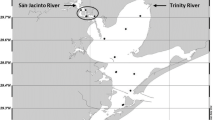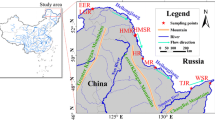Abstract
The southern Changjiang River Estuary has attracted considerable attention from marine scientists because it is a highly biologically active area and is biogeochemically significant. Moreover, land-ocean interactions strongly impact the estuary, and harmful algal blooms (HABs) frequently occur in the area. In October 2010 and May 2011, water samples of chromophoric dissolved organic matter (CDOM) were collected from the southern Changjiang River Estuary. Parallel factor analysis (PARAFAC) was used to assess the samples’ CDOM composition using excitation-emission matrix (EEM) spectroscopy. Four components were identified: three were humic-like (C1, C2 and C3) and one was protein-like (C4). Analysis based on spatial and seasonal distributions, as well as relationships with salinity, Chl a and apparent oxygen utilization (AOU), revealed that terrestrial inputs had the most significant effect on the three humic-like Components C1, C2 and C3 in autumn. In spring, microbial processes and phytoplankton blooms were also important factors that impacted the three components. The protein-like Component C4 had autochthonous and allochthonous origins and likely represented a biologically labile component. CDOM in the southern Changjiang River Estuary was mostly affected by terrestrial inputs. Microbial processes and phytoplankton blooms were also important sources of CDOM, especially in spring. The fluorescence intensities of the four components were significantly higher in spring than in autumn. On average, C1, C2, C3, C4 and the total fluorescence intensity (TFI) in the surface, middle and bottom layers increased by 123%–242%, 105%–195%, 167%–665%, 483%–567% and 184%–245% in spring than in autumn, respectively. This finding corresponded with a Chl a concentration that was 16–20 times higher in spring than in autumn and an AOU that was two to four times lower in spring than in autumn. The humification index (HIX) was lower in spring that in autumn, and the fluorescence index (FI) was higher in spring than in autumn. This result indicated that the CDOM was labile and the biological activity was intense in spring.
Similar content being viewed by others
References
Andersson C A, Bro R. 2000. The N-way Toolbox for MATLAB. Chemometrics and Intelligent Laboratory Systems, 52(1): 1–4
Baber C B, Dobkin D P, Huhdanpaa H. 1996. The Quickhull algorithm for convex hulls. ACM Transaction Mathematical Software, 22(4): 469–483
Birdwell J E, Engel A S. 2010. Characterization of dissolved organic matter in cave and spring waters using UV-vis absorbance and fluorescence spectroscopy. Organic Geochemistry, 41(3): 270–280
Blough N V, Del Vecchio R. 2002. Chromophoric DOM in the coastal environment. In: Hansell D, Carlson C, eds. Biogeochemistry of Marine Dissolved Organic Matter. New York: Academic Press, 509–546
Bro R. 1997. PARAFAC. Tutorial and applications. Chemometrics and Intelligent Laboratory Systems, 38(2): 149–171
Coble P G. 1996. Characterization of marine and terrestrial DOM in seawater using excitation–emission matrix spectroscopy. Marine Chemistry, 51(4): 325–346
Coble P G. 2007. Marine optical biogeochemistry: the chemistry of ocean color. Chemical Reviews, 107(2): 402–418
Cory R M, McKnight D M. 2005. Fluorescence spectroscopy reveals ubiquitous presence of oxidized and reduced quinones in dissolved organic matter. Environment Science & Technology, 39(21): 8142–8149
Gao Lei, Fan Daidu, Li Daoji, et al. 2010. Fluorescence characteristics of chromophoric dissolved organic matter in shallow water along the Zhejiang coasts, southeast China. Marine Environmental Research, 69(3): 187–197
Guéguen C, Granskog M A, McCullough G, et al. 2011. Characterisation of colored dissolved organic matter in Hudson Bay and Hudson Strait using parallel factor analysis. Journal of Marine Systems, 88(3): 423–433
Guo Weidong, Stedmon C A, Han Yuchao, et al. 2007. The conservative and non-conservative behavior of chromophoric dissolved organic matter in Chinese estuarine waters. Marine Chemistry, 107(3): 357–366
Hargreaves B R. 2003. Water column optics and penetration of UVR. In: Helbling E W, Zagarese H E, eds. UV Effects in Aquatic Organisms and Ecosystems. Cambridge UK: The Royal Society of Chemistry, 59–108
Holbrook R D, Yen J H, Grizzard T J. 2006. Characterizing natural organic material from the Occoquan Watershed (Northern Virginia, US) using fluorescence spectroscopy and PARAFAC. Science of the Total Environment, 361(1–2): 249–266
Huguet A, Vacher L, Saubusse S, et al. 2010. New insights into the size distribution of fluorescent dissolved organic matter in estuarine waters. Organic Geochemistry, 41(6): 595–610
Kowalczuk P, Cooper W J, Durako M J, et al. 2010. Characterization of dissolved organic matter fluorescence in the South Atlantic Bight with use of PARAFAC model: Relationships between fluorescence and its components, absorption coefficients and organic carbon concentrations. Marine Chemistry, 118(1–2): 22–36
Kowalczuk P, Durako M J, Young H, et al. 2009. Characterization of dissolved organic matter fluorescence in the South Atlantic Bight with use of PARAFAC model: interannual variability. Marine Chemistry, 113(3–4): 182–196
Li Maotian, Xu Kaiqin, Watanabe M, et al. 2007. Long-term variations in dissolved silicate, nitrogen, and phosphorus flux from the Yangtze River into the East China Sea and impacts on estuarine ecosystem. Estuarine, Coastal and Shelf Science, 71(1–2): 3–12
Lin Jing. 2007. Distributions of dissolved organic carbon and particulate organic carbon in the Changjiang Estuary and its adjacent area (in Chinese) [dissertation]. Shanghai: East China Normal University
Liu J P, Xu K H, Li A C, et al. 2007. Flux and fate of Yangtze River sediment delivered to the East China Sea. Geomorphology, 85(3–4): 208–224
Luciani X, Mounier S, Paraquetti H H M, et al. 2008. Tracing of dissolved organic matter from the SEPETIBA Bay (Brazil) by PARAFAC analysis of total luminescence matrices. Marine Environmental Research, 65(2): 148–157
Maie N, Yamashita Y, Cory R M, et al. 2012. Application of excitation emission matrix fluorescence monitoring in the assessment of spatial and seasonal drivers of dissolved organic matter composition: Sources and physical disturbance controls. Applied Geochemistry, 27(4): 917–929
McKnight D M, Boyer E W, Westerhoff P K, et al. 2001. Spectrofluorometric characterization of dissolved organic matter for indication of precursor organic material and aromaticity. Limnology and Oceanography, 46(1): 38–48
Murphy K R, Stedmon C A, Waite T D, et al. 2008. Distinguishing between terrestrial and autochthonous organic matter sources in marine environments using fluorescence spectroscopy. Marine Chemistry, 108(1–2): 40–58
Nieke B, Reuter R, Heuermann R, et al. 1997. Light absorption and fluorescence properties of chromophoric dissolved organic matter (CDOM), in the St. Lawrence estuary (Case 2 waters). Continental Shelf Research, 17(3): 235–252
Ning X, Liu Z, Cai Y, et al. 1998. Physicobiological oceanographic remote sensing of the East China Sea: satellite and in situ observations. Journal of Geophysical Research: Oceans, 103(C10): 21623–21635
Ogawa H, Usui T, Koike I. 2003. Distribution of dissolved organic carbon in the East China Sea. Deep-Sea Research Part II: Topical Studies in Oceanography, 50(2): 353–366
Ohno T. 2002. Fluorescence inner-filtering correction for determining the humification index of dissolved organic matter. Environmental Science & Technology, 36(4): 742–746
Parlanti E, Wörz K, Geoffroy L, et al. 2000. Dissolved organic matter fluorescence spectroscopy as a tool to estimate biological activity in a coastal zone submitted to anthropogenic inputs. Organic Geochemistry, 31(12): 1765–1781
Shi Wei, Wang Menghua. 2012. Satellite views of the Bohai Sea, Yellow Sea, and East China Sea. Progress in Oceanography, 104: 30–45
Singh S, D'Sa E J, Swenson E M. 2010. Chromophoric dissolved organic matter (CDOM) variability in Barataria Basin using excitation–emission matrix (EEM) fluorescence and parallel factor analysis (PARAFAC). Science of the Total Environment, 408(16): 3211–3222
Stedmon C A, Bro R. 2008. Characterizing dissolved organic matter fluorescence with parallel factor analysis: a tutorial. Limnology and Oceanography: Methods, 6(11): 572–579
Stedmon C A, Markager S. 2005a. Resolving the variability in dissolved organic matter fluorescence in a temperate estuary and its catchment using PARAFAC analysis. Limnology and Oceanography, 50(2): 686–697
Stedmon C A, Markager S. 2005b. Tracing the production and degradation of autochthonous fractions of dissolved organic matter by fluorescence analysis. Limnology and Oceanography, 50(5): 1415–1426
Stedmon C A, Markager S, Bro R. 2003. Tracing dissolved organic matter in aquatic environments using a new approach to fluorescence spectroscopy. Marine Chemistry, 82(3–4): 239–254
Tian R C, Hu F X, Martin J M. 1993. Summer nutrient fronts in the Changjiang (Yangtze River) estuary. Estuarine, Coastal and Shelf Science, 37(1): 27–41
Wada S, Aoki M N, Tsuchiya Y, et al. 2007. Quantitative and qualitative analyses of dissolved organic matter released from Ecklonia cava Kjellman, in Oura Bay, Shimoda, Izu Peninsula, Japan. Journal of Experimental Marine Biology and Ecology, 349(2): 344–358
Wang Zhaoyu, Wang Jiangtao, Tan Liju. 2014. Variation in photosynthetic activity of phytoplankton during the spring algal blooms in the adjacent area of Changjiang River estuary. Ecological Indicators, 45: 465–473
Wang Baodong, Wang Xiulin, Zhan Run. 2003. Nutrient conditions in the Yellow Sea and the East China Sea. Estuarine, Coastal and Shelf Science, 58(1): 127–136
Yamashita Y, Jaffé R, Maie N, et al. 2008. Assessing the dynamics of dissolved organic matter (DOM) in coastal environments by excitation emission matrix fluorescence and parallel factor analysis (EEM-PARAFAC). Limnology and Oceanography, 53(5): 1900–1908
Yang Liyang, Hong Huasheng, Chen C–T A, et al. 2013. Chromophoric dissolved organic matter in the estuaries of populated and mountainous Taiwan. Marine Chemistry, 157: 12–23
Zepp R G, Sheldon W M, Moran M A. 2004. Dissolved organic fluorophores in southeastern US coastal waters: correction method for eliminating Rayleigh and Raman scattering peaks in excitation–emission matrices. Marine Chemistry, 89(1–4): 15–36
Zhang Jing. 1996. Nutrient elements in large Chinese estuaries. Continental Shelf Research, 16(8): 1023–1045
Zhang Yunlin, Liu Xiaohan, Wang Mingzhu, et al. 2013. Compositional differences of chromophoric dissolved organic matter derived from phytoplankton and macrophytes. Organic Geochemistry, 55: 26–37
Zhang G L, Zhang J, Kang Y B, et al. 2004. Distributions and fluxes of methane in the East China Sea and the Yellow Sea in spring. Journal of Geophysical Research: Oceans, 109(C7): C07011
Zhou Mingjiang, Shen Zhiliang, Yu Rencheng. 2008. Responses of a coastal phytoplankton community to increased nutrient input from the Changjiang (Yangtze) River. Continental Shelf Research, 28(12): 1483–1489
Zhu Chun, Wang Zhanghua, Xue Bin, et al. 2011. Characterizing the depositional settings for sedimentary organic matter distributions in the Lower Yangtze River-East China Sea Shelf System. Estuarine, Coastal and Shelf Science, 93(1): 182–191
Zsolnay A, Baigar E, Jimenez M, et al. 1999. Differentiating with fluorescence spectroscopy the sources of dissolved organic matter in soils subjected to drying. Chemosphere, 38(1): 45–50
Author information
Authors and Affiliations
Corresponding author
Additional information
Foundation item: The National Natural Science Foundation of China under contract No. 41376106; the Major Science and Technology Program for Water Pollution Control and Treatment under contract No. 2012ZX07501.
Rights and permissions
About this article
Cite this article
Bai, Y., Su, R., Han, X. et al. Investigation of seasonal variability of CDOM fluorescence in the southern changjiang river estuary by EEM-PARAFAC. Acta Oceanol. Sin. 34, 1–12 (2015). https://doi.org/10.1007/s13131-015-0714-8
Received:
Accepted:
Published:
Issue Date:
DOI: https://doi.org/10.1007/s13131-015-0714-8




